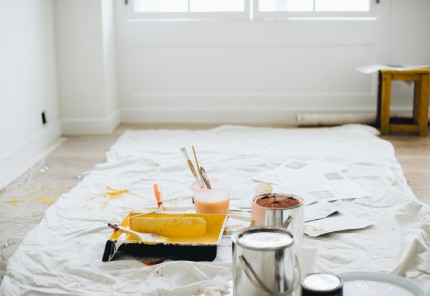The holidays are just around the corner, which means many of you are planning family gatherings in your homes. During this time of year, there’s no better way to bring the feeling of warmth and delight into your home than adding a fresh coat of paint. There’s only one problem – with the windows and doors shut tight to keep out the cold, painting your home’s interior can be more harmful than good if you don’t choose safe products with reduced toxic emissions.
There are hundreds of paint choices to choose from but not all of them are healthy and environmentally friendly. The experts of Concord, NH painters remind you of the following tips to make your interior painting project a safe one:
- Look for low volatile organic compound (VOC) paints. You have probably noticed the strong smell of a newly painted room. The odor comes from VOCs, which are found in most traditional paints. These VOCs escape into the air after they are applied indoors. According to the Environmental Protection Agency, prolonged exposure to VOCs can cause upper respiratory problems, and extended exposure can even cause kidney and liver disease. When painting with VOCs, the amount of toxins inside your home is greater than the amount outside, due mostly to the lack of ventilation. The alternative to VOC products is water-based paint, which contains fewer toxins than traditional.
- Don’t overbuy. Think realistically when picking out paint, and measure the size of the room before you go to the store to purchase. One gallon of paint can cover up to 400 square feet. If you’re not sure how much you’ll need, a paint store associate can help you determine how much you’ll need. Disposing of paint takes some work, so by carefully planning out how much you’ll need, you’re able to save money and the environment.
- Keep windows and doors open. Despite it being cold outside, it’s important to allow for as much circulation to enter your home as you can. Keep doors and windows open while you are painting and allow them to remain open for a few hours after painting. This will also help speed up the drying process.
- Reuse leftover paint. If you have extra paint leftover when you’re done, don’t dispose of it! Instead, save any leftover paint you may have to use for minor spot repairs and touch-ups. If you have no need for it, consider donating leftover paints to someone who might use them, like a local church, school, or a friend.
Look out for the health of others this season by choosing environmentally-safe products for your interior paint projects. Transform your home with a coat of paint and welcome guests in this holiday season knowing that you and your family are breathing far fewer pollutants inside your home.
Want to guarantee a safe paint job that looks beautiful? Contact the experts at CertaPro today to have your holiday house painting scheduled.




